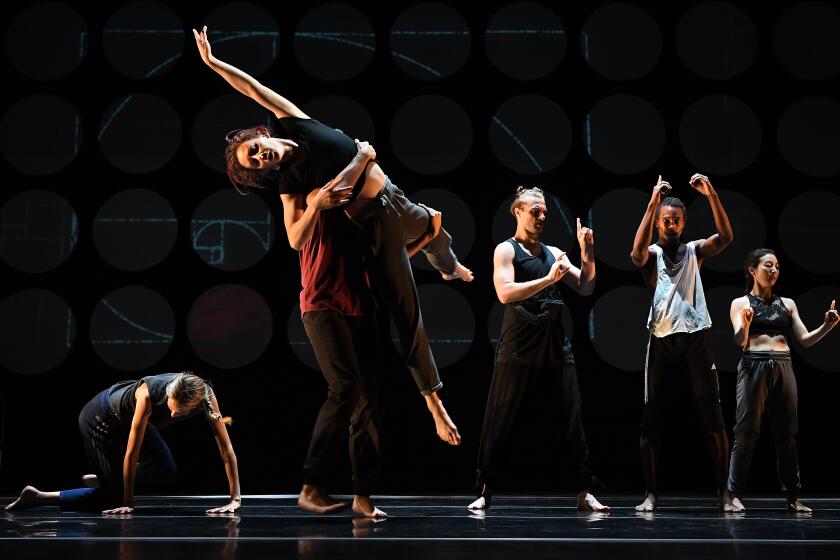Review: In a breakthrough show, Invertigo Dance takes a delicious bite from a forbidden apple
The persecution of British computer scientist Alan Turing makes you want to scream.
Although Turing was key in decoding German military messages during World War II and his efforts likely saved millions of lives, seven years after war’s end the British government prosecuted him for his homosexuality and forced him to undergo a chemical castration. Turin killed himself in 1954 by eating a cyanide-laced apple — a horrid and at the same time poetic ending for a genius who loved the Disney movie “Snow White and the Seven Dwarfs.”
Laura Karlin, artistic director of Invertigo Dance Theatre, has been just about obsessed with Turing’s life and work. She has wanted for years to turn it all into a stage production, and she has finally done it with “Formulae & Fairy Tales,” which had its premiere Friday at the Broad Stage in Santa Monica.
Invertigo Dance Theatre’s “Formulae & Fairy Tales” makes its world premiere at the Broad Stage in Santa Monica.
The 70-minute dance is a breakthrough for Karlin and Invertigo, founded in 2007. And though the choreographer is probably screaming in her gut, she had the wisdom to keep her seven performers from outwardly doing so. Karlin and the dancers she credits as her co-choreographers have judiciously chosen to present the injustices of Turing’s life without hysterical raging, and that decision makes the work all the more meaningful and poignant.
The title “Formulae & Fairy Tales” doesn’t exactly glide off the tongue, but then neither does the idea of using movement to sync together so many complicated ideas. “Formulae & Fairy Tales” beautifully carries the audience from scenes of innocent childhood play to visions of romantic love, from high-level mathematics and artificial intelligence to war, gender categorization, Adam and Eve, and Snow White.
This is not straight biography. Dancer Cody Brunelle-Potter serves as narrator throughout, giving us just enough information about Turing. An audience member comes onstage, and when she is unable to do a multi-digit multiplication problem in her head, Brunelle-Potter announces she has failed the Turing Test, proving she’s not a machine.
In two tableaux of happiness (dancers wiggle their hands like birds or butterflies), Karlin introduces a heterosexual couple and then a same-sex couple, both of them disrupted by the gift of a very red apple. This is the only splash of color in a ballet that is almost entirely black, white and grays (thanks to the effective lighting designs by R. S. Buck and stylish costumes by Rosalida Medina). A video grid of 44 circles is projected on the backdrop (designs by NightLight Labs), and images of bombs exploding and scrolling numbers also are part of the visual storytelling.
Movement choices effectively signal even arcane concepts. The dancers assume angular shifting poses to suggest metallic computer machinery. Balletic lifts and flowing circular partnering present hope, kindness and support. The original score by Toby Karlin, the choreographer’s brother, along with Julia Kent and Eric Mason provided melodic interludes for the poetic swirling of dancers Hyosun Choi, Jessica Dunn, Spencer Jensen, Corina Kinnear, Dominique McDougal and Luke Dakota Zender.
In a few places, “Formulae” fails to hit the mark or undercuts its own purpose. At one point, men and women sashay about the stage, all using exaggerated female tropes, while a recorded voice intones an uncanny quote from Turing: “One day ladies will take their computers for walks in the park and tell each other, ‘My little computer said such a funny thing this morning.’ ” Funny, yes, but why resort to the very stereotypes being questioned?
Fall is the perfect time to immerse yourself in the beauty of dance — from homegrown talent to global ensembles.
A few borrowed lines from novelist and professor Janna Levin about where to begin the ballet, because everything is circular and there’s no such thing as a beginning, sounded like precious double-talk.
The ballet’s penultimate moments, though, are among its finest. Dakota Zender and Jensen folded around each other in an angelic embrace — connected by an apple in their mouths. This was a moment of glorious passion, sweet and undeniable.
Support continuing coverage of SoCal dance. Become a digital subscriber.
More to Read
The biggest entertainment stories
Get our big stories about Hollywood, film, television, music, arts, culture and more right in your inbox as soon as they publish.
You may occasionally receive promotional content from the Los Angeles Times.











